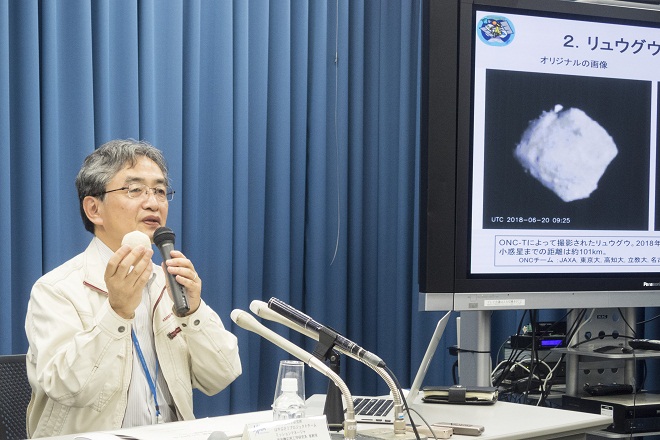Japan’s Hayabusa2 Reaches Target Asteroid
June 27, 2018
Tokyo- Japanese asteroid explorer Hayabusa2 reached its target, Ryugu, on Wednesday morning, the Japan Aerospace Exploration Agency, or JAXA, said the same day.
At 9:35 a.m. (12:35 a.m. GMT), Hayabusa2 positioned itself at a fixed reference point 20 kilometers above the near-Earth asteroid, according to JAXA.
For about a year and a half through the end of 2019, the probe will carry out observations of Ryugu. It will return to Earth at the end of 2020.
As Ryugu is thought to contain water and organic matter, its observations are expected to help explain the origin of life on Earth.
The asteroid, which revolves around the sun between the orbits of Earth and Mars, has a diameter of about 900 meters. Its rotational period is about 7.5 hours.
Hayabusa2 was launched in December 2014 from JAXA's Tanegashima Space Center in Kagoshima Prefecture, southwestern Japan.
In December 2015, it successfully conducted an Earth swing-by to accelerate toward Ryugu by using the planet's gravity.
Gathering speed with its ion engines, Hayabusa2 traveled 3.2 billion kilometers over a period of about three and a half years. It reached a point some 2,100 kilometers away from Ryugu on June 3 this year, completing outward journey operations of its ion engines.
Hayabusa2 then repeatedly made course corrections to gradually approach Ryugu, using its camera to check the location of the asteroid and the distance to it.
It will land on the asteroid three times to collect samples. The first landing is scheduled in October this year.
Also for observations, Hayabusa2 will place small probes on Ryugu and launch an explosives-laden impactor to create a crater on the asteroid's surface.
When returning to Earth, Hayabusa2 will enter the atmosphere after detaching itself from a capsule containing the Ryugu samples.
Low-mass asteroids are believed to be retaining their original features dating back to when the solar system was formed some 4.6 billion years ago because their component materials are little affected by heat and pressure.
While asteroid Itokawa, whose particles were brought back to Earth by the first Hayabusa explorer in 2010, is an S-type asteroid that contains little water, Ryugu is a C-type asteroid containing organic matter, which is the origin of water and life.
Asteroids are thought to be the source of organic matter in Earth. Jiji Press
Latest Videos
- THE UNTOLD STORY EXPERT INSIGHTS INTO THE UKRAINE
- NEGOTIATING A NEW ORDER US RUSSIA TALKS ON UKRAIN
- Ukraine: A Pawn in the Geopolitical Game? Will Trump Intervene?
- US VP VANCE CRITICIZES EUROPEAN DEMOCRACIES AT MUNICH SECURITY CONFERENCE
- UNCOVERING THE WEB OF DECEIT: CIA INFILTRATION OF THE MEDIA
- SHIFTING SANDS: TULSI GABBARD’S CONFIRMATION AND THE EVOLVING GLOBAL LANDSCAPE
- FAUCI SCANDAL: A THREAT TO GLOBAL HEALTH AND DEMOCRACY






